Organizational Culture and Management Approaches in Human Services
VerifiedAdded on 2022/11/07
|7
|2218
|170
Report
AI Summary
This report examines organizational culture and management approaches, focusing on bureaucratic and participatory management theories. It begins by defining bureaucratic management, drawing on the work of Max Weber and Henri Fayol, and highlighting its emphasis on hierarchy, rules, and objectivity. The report then provides an example of bureaucratic management at the University of New South Wales, detailing its hierarchical structure and operational procedures. The benefits of bureaucratic management, such as control, consistency, and objectivity, are discussed, along with its limitations, including reduced flexibility and potential for dissatisfaction. The report then shifts to participatory management, which encourages employee involvement in decision-making. It references the Hawthorne experiments and describes the implementation of participatory management in a public hospital in Alberta, Canada, highlighting increased collaboration and job satisfaction. The benefits of participatory management, such as innovation and employee empowerment, are contrasted with potential challenges like arrogance and conflicts. The report concludes by emphasizing the effectiveness of both management styles in specific contexts and the importance of understanding their respective strengths and weaknesses for effective organizational management.
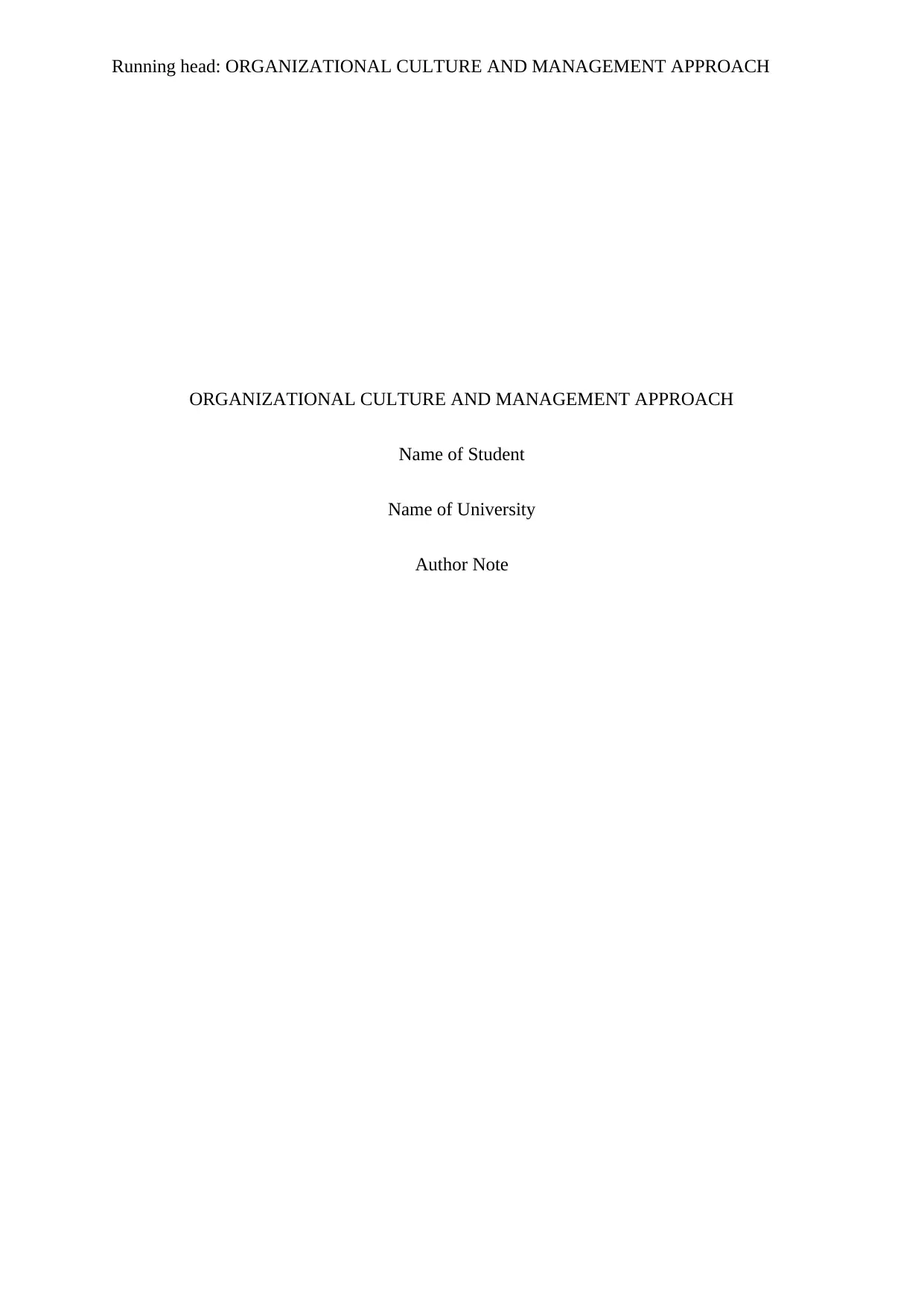
Running head: ORGANIZATIONAL CULTURE AND MANAGEMENT APPROACH
ORGANIZATIONAL CULTURE AND MANAGEMENT APPROACH
Name of Student
Name of University
Author Note
ORGANIZATIONAL CULTURE AND MANAGEMENT APPROACH
Name of Student
Name of University
Author Note
Paraphrase This Document
Need a fresh take? Get an instant paraphrase of this document with our AI Paraphraser
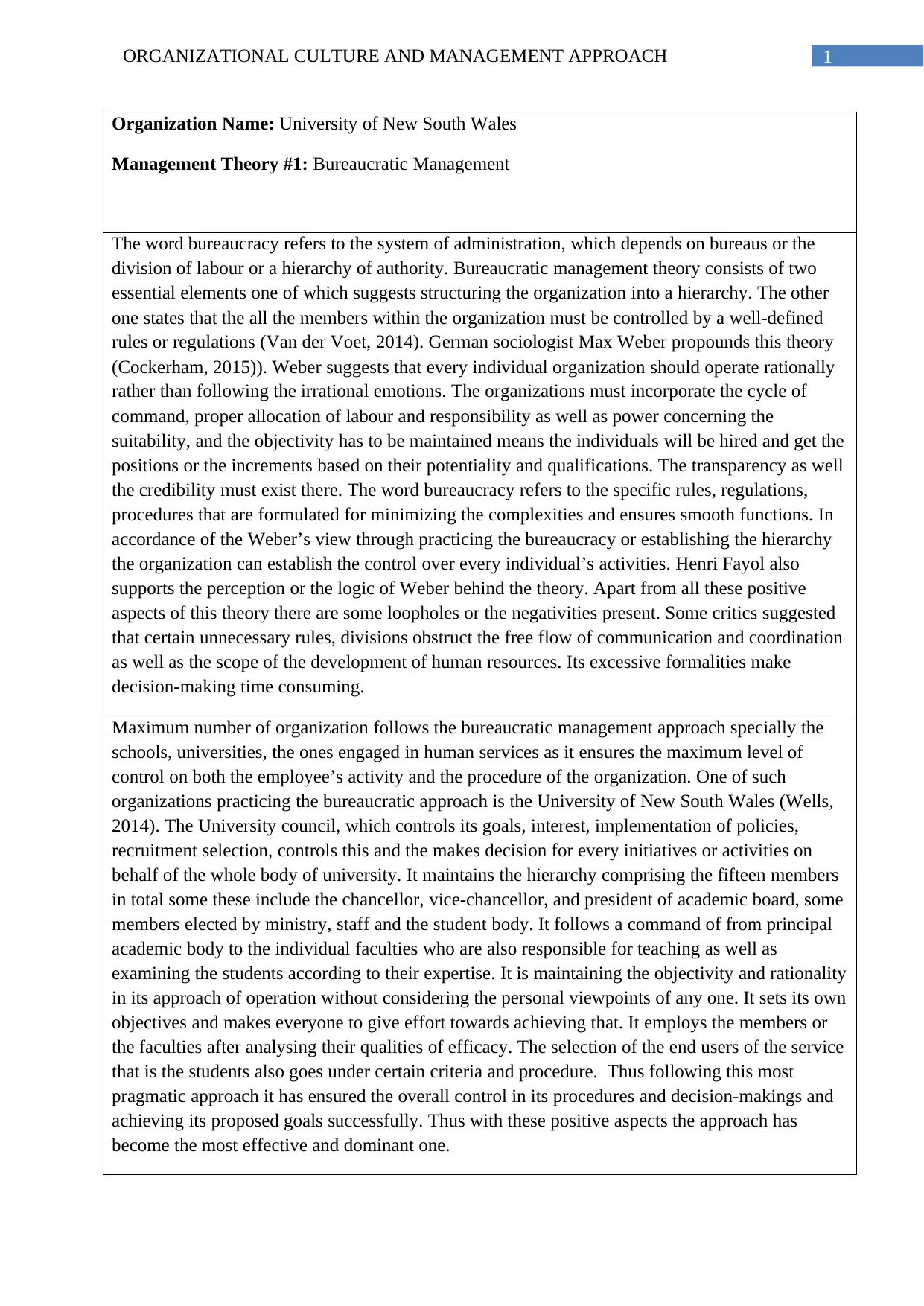
1ORGANIZATIONAL CULTURE AND MANAGEMENT APPROACH
Organization Name: University of New South Wales
Management Theory #1: Bureaucratic Management
The word bureaucracy refers to the system of administration, which depends on bureaus or the
division of labour or a hierarchy of authority. Bureaucratic management theory consists of two
essential elements one of which suggests structuring the organization into a hierarchy. The other
one states that the all the members within the organization must be controlled by a well-defined
rules or regulations (Van der Voet, 2014). German sociologist Max Weber propounds this theory
(Cockerham, 2015)). Weber suggests that every individual organization should operate rationally
rather than following the irrational emotions. The organizations must incorporate the cycle of
command, proper allocation of labour and responsibility as well as power concerning the
suitability, and the objectivity has to be maintained means the individuals will be hired and get the
positions or the increments based on their potentiality and qualifications. The transparency as well
the credibility must exist there. The word bureaucracy refers to the specific rules, regulations,
procedures that are formulated for minimizing the complexities and ensures smooth functions. In
accordance of the Weber’s view through practicing the bureaucracy or establishing the hierarchy
the organization can establish the control over every individual’s activities. Henri Fayol also
supports the perception or the logic of Weber behind the theory. Apart from all these positive
aspects of this theory there are some loopholes or the negativities present. Some critics suggested
that certain unnecessary rules, divisions obstruct the free flow of communication and coordination
as well as the scope of the development of human resources. Its excessive formalities make
decision-making time consuming.
Maximum number of organization follows the bureaucratic management approach specially the
schools, universities, the ones engaged in human services as it ensures the maximum level of
control on both the employee’s activity and the procedure of the organization. One of such
organizations practicing the bureaucratic approach is the University of New South Wales (Wells,
2014). The University council, which controls its goals, interest, implementation of policies,
recruitment selection, controls this and the makes decision for every initiatives or activities on
behalf of the whole body of university. It maintains the hierarchy comprising the fifteen members
in total some these include the chancellor, vice-chancellor, and president of academic board, some
members elected by ministry, staff and the student body. It follows a command of from principal
academic body to the individual faculties who are also responsible for teaching as well as
examining the students according to their expertise. It is maintaining the objectivity and rationality
in its approach of operation without considering the personal viewpoints of any one. It sets its own
objectives and makes everyone to give effort towards achieving that. It employs the members or
the faculties after analysing their qualities of efficacy. The selection of the end users of the service
that is the students also goes under certain criteria and procedure. Thus following this most
pragmatic approach it has ensured the overall control in its procedures and decision-makings and
achieving its proposed goals successfully. Thus with these positive aspects the approach has
become the most effective and dominant one.
Organization Name: University of New South Wales
Management Theory #1: Bureaucratic Management
The word bureaucracy refers to the system of administration, which depends on bureaus or the
division of labour or a hierarchy of authority. Bureaucratic management theory consists of two
essential elements one of which suggests structuring the organization into a hierarchy. The other
one states that the all the members within the organization must be controlled by a well-defined
rules or regulations (Van der Voet, 2014). German sociologist Max Weber propounds this theory
(Cockerham, 2015)). Weber suggests that every individual organization should operate rationally
rather than following the irrational emotions. The organizations must incorporate the cycle of
command, proper allocation of labour and responsibility as well as power concerning the
suitability, and the objectivity has to be maintained means the individuals will be hired and get the
positions or the increments based on their potentiality and qualifications. The transparency as well
the credibility must exist there. The word bureaucracy refers to the specific rules, regulations,
procedures that are formulated for minimizing the complexities and ensures smooth functions. In
accordance of the Weber’s view through practicing the bureaucracy or establishing the hierarchy
the organization can establish the control over every individual’s activities. Henri Fayol also
supports the perception or the logic of Weber behind the theory. Apart from all these positive
aspects of this theory there are some loopholes or the negativities present. Some critics suggested
that certain unnecessary rules, divisions obstruct the free flow of communication and coordination
as well as the scope of the development of human resources. Its excessive formalities make
decision-making time consuming.
Maximum number of organization follows the bureaucratic management approach specially the
schools, universities, the ones engaged in human services as it ensures the maximum level of
control on both the employee’s activity and the procedure of the organization. One of such
organizations practicing the bureaucratic approach is the University of New South Wales (Wells,
2014). The University council, which controls its goals, interest, implementation of policies,
recruitment selection, controls this and the makes decision for every initiatives or activities on
behalf of the whole body of university. It maintains the hierarchy comprising the fifteen members
in total some these include the chancellor, vice-chancellor, and president of academic board, some
members elected by ministry, staff and the student body. It follows a command of from principal
academic body to the individual faculties who are also responsible for teaching as well as
examining the students according to their expertise. It is maintaining the objectivity and rationality
in its approach of operation without considering the personal viewpoints of any one. It sets its own
objectives and makes everyone to give effort towards achieving that. It employs the members or
the faculties after analysing their qualities of efficacy. The selection of the end users of the service
that is the students also goes under certain criteria and procedure. Thus following this most
pragmatic approach it has ensured the overall control in its procedures and decision-makings and
achieving its proposed goals successfully. Thus with these positive aspects the approach has
become the most effective and dominant one.
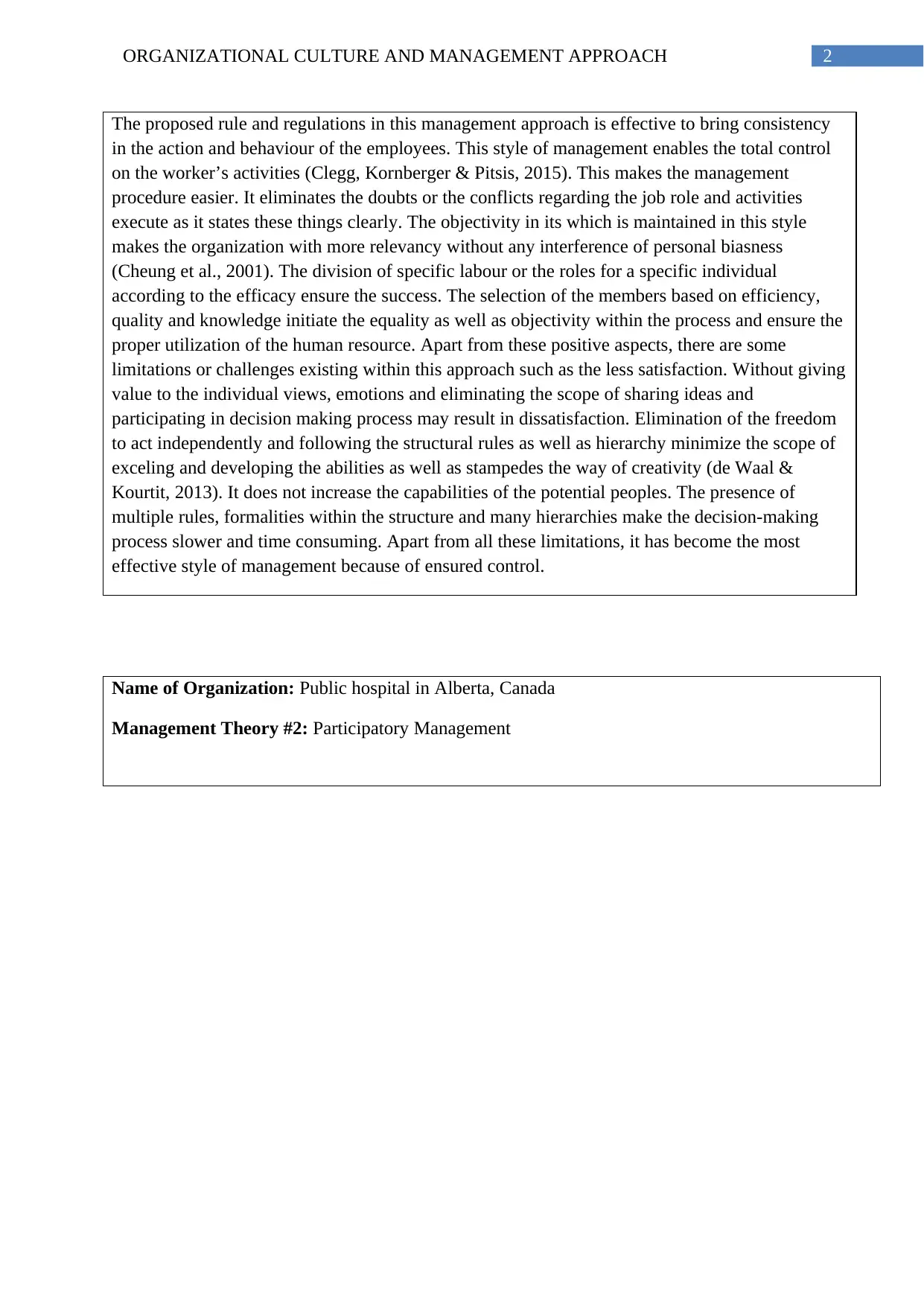
2ORGANIZATIONAL CULTURE AND MANAGEMENT APPROACH
The proposed rule and regulations in this management approach is effective to bring consistency
in the action and behaviour of the employees. This style of management enables the total control
on the worker’s activities (Clegg, Kornberger & Pitsis, 2015). This makes the management
procedure easier. It eliminates the doubts or the conflicts regarding the job role and activities
execute as it states these things clearly. The objectivity in its which is maintained in this style
makes the organization with more relevancy without any interference of personal biasness
(Cheung et al., 2001). The division of specific labour or the roles for a specific individual
according to the efficacy ensure the success. The selection of the members based on efficiency,
quality and knowledge initiate the equality as well as objectivity within the process and ensure the
proper utilization of the human resource. Apart from these positive aspects, there are some
limitations or challenges existing within this approach such as the less satisfaction. Without giving
value to the individual views, emotions and eliminating the scope of sharing ideas and
participating in decision making process may result in dissatisfaction. Elimination of the freedom
to act independently and following the structural rules as well as hierarchy minimize the scope of
exceling and developing the abilities as well as stampedes the way of creativity (de Waal &
Kourtit, 2013). It does not increase the capabilities of the potential peoples. The presence of
multiple rules, formalities within the structure and many hierarchies make the decision-making
process slower and time consuming. Apart from all these limitations, it has become the most
effective style of management because of ensured control.
Name of Organization: Public hospital in Alberta, Canada
Management Theory #2: Participatory Management
The proposed rule and regulations in this management approach is effective to bring consistency
in the action and behaviour of the employees. This style of management enables the total control
on the worker’s activities (Clegg, Kornberger & Pitsis, 2015). This makes the management
procedure easier. It eliminates the doubts or the conflicts regarding the job role and activities
execute as it states these things clearly. The objectivity in its which is maintained in this style
makes the organization with more relevancy without any interference of personal biasness
(Cheung et al., 2001). The division of specific labour or the roles for a specific individual
according to the efficacy ensure the success. The selection of the members based on efficiency,
quality and knowledge initiate the equality as well as objectivity within the process and ensure the
proper utilization of the human resource. Apart from these positive aspects, there are some
limitations or challenges existing within this approach such as the less satisfaction. Without giving
value to the individual views, emotions and eliminating the scope of sharing ideas and
participating in decision making process may result in dissatisfaction. Elimination of the freedom
to act independently and following the structural rules as well as hierarchy minimize the scope of
exceling and developing the abilities as well as stampedes the way of creativity (de Waal &
Kourtit, 2013). It does not increase the capabilities of the potential peoples. The presence of
multiple rules, formalities within the structure and many hierarchies make the decision-making
process slower and time consuming. Apart from all these limitations, it has become the most
effective style of management because of ensured control.
Name of Organization: Public hospital in Alberta, Canada
Management Theory #2: Participatory Management
⊘ This is a preview!⊘
Do you want full access?
Subscribe today to unlock all pages.

Trusted by 1+ million students worldwide
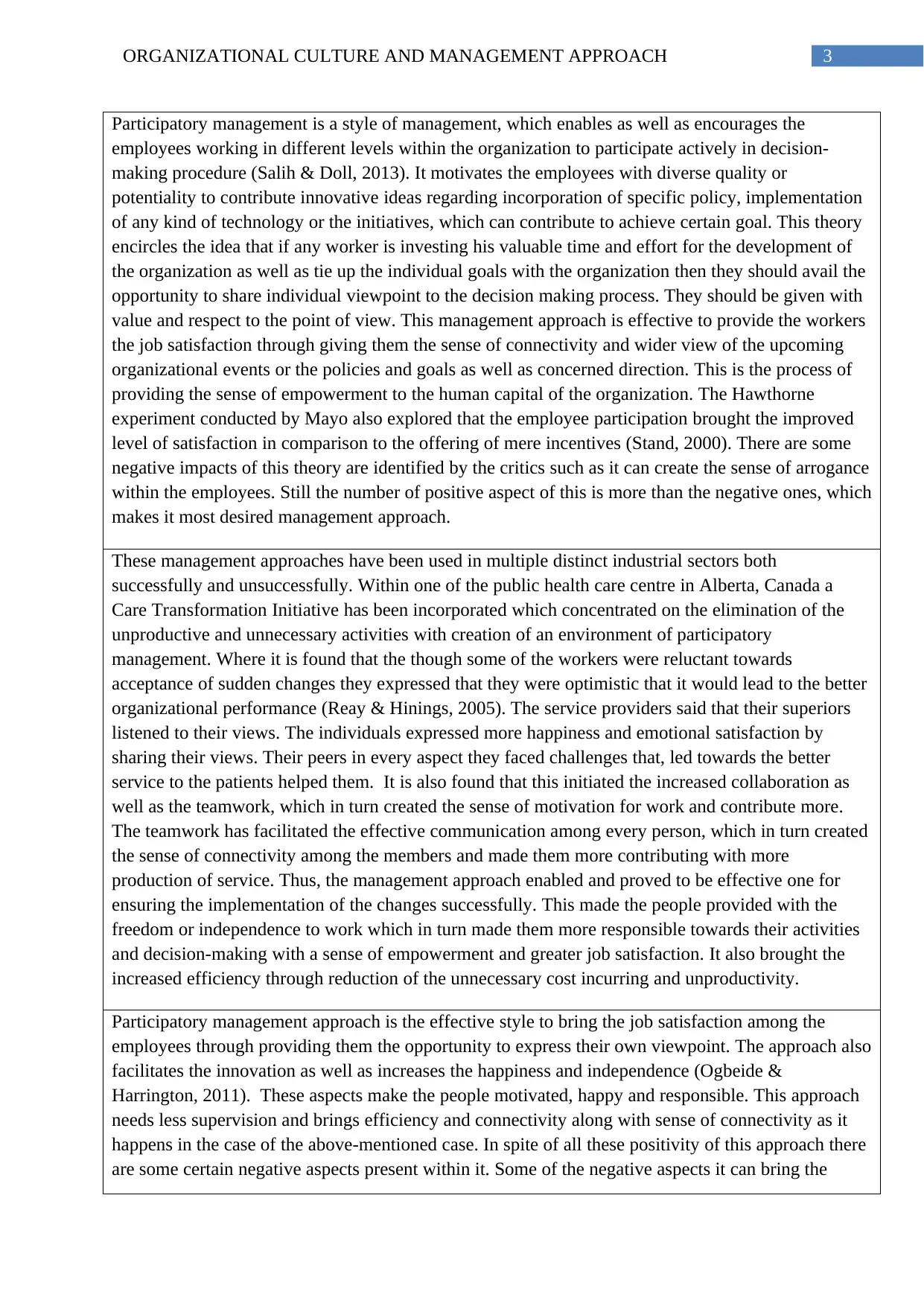
3ORGANIZATIONAL CULTURE AND MANAGEMENT APPROACH
Participatory management is a style of management, which enables as well as encourages the
employees working in different levels within the organization to participate actively in decision-
making procedure (Salih & Doll, 2013). It motivates the employees with diverse quality or
potentiality to contribute innovative ideas regarding incorporation of specific policy, implementation
of any kind of technology or the initiatives, which can contribute to achieve certain goal. This theory
encircles the idea that if any worker is investing his valuable time and effort for the development of
the organization as well as tie up the individual goals with the organization then they should avail the
opportunity to share individual viewpoint to the decision making process. They should be given with
value and respect to the point of view. This management approach is effective to provide the workers
the job satisfaction through giving them the sense of connectivity and wider view of the upcoming
organizational events or the policies and goals as well as concerned direction. This is the process of
providing the sense of empowerment to the human capital of the organization. The Hawthorne
experiment conducted by Mayo also explored that the employee participation brought the improved
level of satisfaction in comparison to the offering of mere incentives (Stand, 2000). There are some
negative impacts of this theory are identified by the critics such as it can create the sense of arrogance
within the employees. Still the number of positive aspect of this is more than the negative ones, which
makes it most desired management approach.
These management approaches have been used in multiple distinct industrial sectors both
successfully and unsuccessfully. Within one of the public health care centre in Alberta, Canada a
Care Transformation Initiative has been incorporated which concentrated on the elimination of the
unproductive and unnecessary activities with creation of an environment of participatory
management. Where it is found that the though some of the workers were reluctant towards
acceptance of sudden changes they expressed that they were optimistic that it would lead to the better
organizational performance (Reay & Hinings, 2005). The service providers said that their superiors
listened to their views. The individuals expressed more happiness and emotional satisfaction by
sharing their views. Their peers in every aspect they faced challenges that, led towards the better
service to the patients helped them. It is also found that this initiated the increased collaboration as
well as the teamwork, which in turn created the sense of motivation for work and contribute more.
The teamwork has facilitated the effective communication among every person, which in turn created
the sense of connectivity among the members and made them more contributing with more
production of service. Thus, the management approach enabled and proved to be effective one for
ensuring the implementation of the changes successfully. This made the people provided with the
freedom or independence to work which in turn made them more responsible towards their activities
and decision-making with a sense of empowerment and greater job satisfaction. It also brought the
increased efficiency through reduction of the unnecessary cost incurring and unproductivity.
Participatory management approach is the effective style to bring the job satisfaction among the
employees through providing them the opportunity to express their own viewpoint. The approach also
facilitates the innovation as well as increases the happiness and independence (Ogbeide &
Harrington, 2011). These aspects make the people motivated, happy and responsible. This approach
needs less supervision and brings efficiency and connectivity along with sense of connectivity as it
happens in the case of the above-mentioned case. In spite of all these positivity of this approach there
are some certain negative aspects present within it. Some of the negative aspects it can bring the
Participatory management is a style of management, which enables as well as encourages the
employees working in different levels within the organization to participate actively in decision-
making procedure (Salih & Doll, 2013). It motivates the employees with diverse quality or
potentiality to contribute innovative ideas regarding incorporation of specific policy, implementation
of any kind of technology or the initiatives, which can contribute to achieve certain goal. This theory
encircles the idea that if any worker is investing his valuable time and effort for the development of
the organization as well as tie up the individual goals with the organization then they should avail the
opportunity to share individual viewpoint to the decision making process. They should be given with
value and respect to the point of view. This management approach is effective to provide the workers
the job satisfaction through giving them the sense of connectivity and wider view of the upcoming
organizational events or the policies and goals as well as concerned direction. This is the process of
providing the sense of empowerment to the human capital of the organization. The Hawthorne
experiment conducted by Mayo also explored that the employee participation brought the improved
level of satisfaction in comparison to the offering of mere incentives (Stand, 2000). There are some
negative impacts of this theory are identified by the critics such as it can create the sense of arrogance
within the employees. Still the number of positive aspect of this is more than the negative ones, which
makes it most desired management approach.
These management approaches have been used in multiple distinct industrial sectors both
successfully and unsuccessfully. Within one of the public health care centre in Alberta, Canada a
Care Transformation Initiative has been incorporated which concentrated on the elimination of the
unproductive and unnecessary activities with creation of an environment of participatory
management. Where it is found that the though some of the workers were reluctant towards
acceptance of sudden changes they expressed that they were optimistic that it would lead to the better
organizational performance (Reay & Hinings, 2005). The service providers said that their superiors
listened to their views. The individuals expressed more happiness and emotional satisfaction by
sharing their views. Their peers in every aspect they faced challenges that, led towards the better
service to the patients helped them. It is also found that this initiated the increased collaboration as
well as the teamwork, which in turn created the sense of motivation for work and contribute more.
The teamwork has facilitated the effective communication among every person, which in turn created
the sense of connectivity among the members and made them more contributing with more
production of service. Thus, the management approach enabled and proved to be effective one for
ensuring the implementation of the changes successfully. This made the people provided with the
freedom or independence to work which in turn made them more responsible towards their activities
and decision-making with a sense of empowerment and greater job satisfaction. It also brought the
increased efficiency through reduction of the unnecessary cost incurring and unproductivity.
Participatory management approach is the effective style to bring the job satisfaction among the
employees through providing them the opportunity to express their own viewpoint. The approach also
facilitates the innovation as well as increases the happiness and independence (Ogbeide &
Harrington, 2011). These aspects make the people motivated, happy and responsible. This approach
needs less supervision and brings efficiency and connectivity along with sense of connectivity as it
happens in the case of the above-mentioned case. In spite of all these positivity of this approach there
are some certain negative aspects present within it. Some of the negative aspects it can bring the
Paraphrase This Document
Need a fresh take? Get an instant paraphrase of this document with our AI Paraphraser
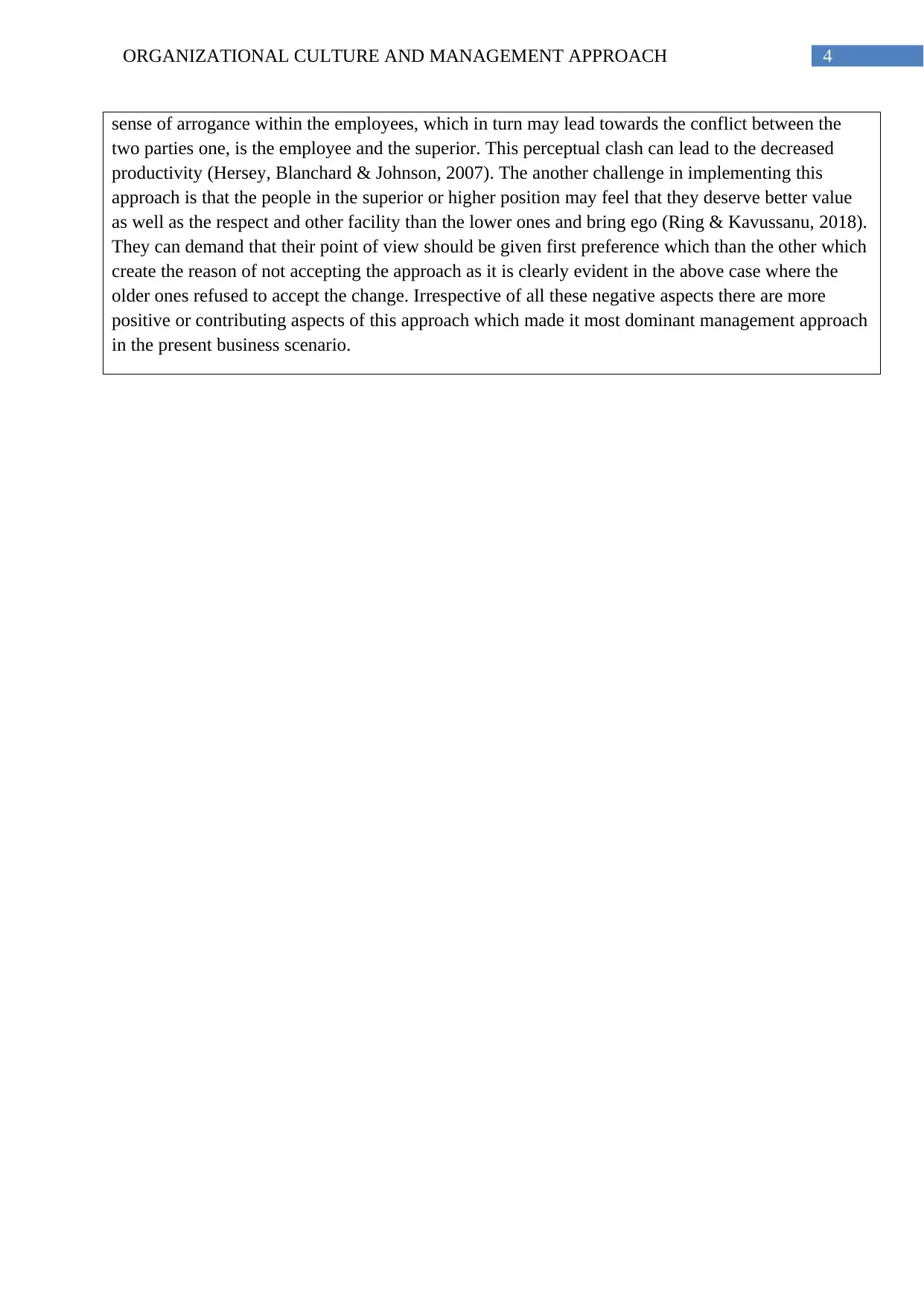
4ORGANIZATIONAL CULTURE AND MANAGEMENT APPROACH
sense of arrogance within the employees, which in turn may lead towards the conflict between the
two parties one, is the employee and the superior. This perceptual clash can lead to the decreased
productivity (Hersey, Blanchard & Johnson, 2007). The another challenge in implementing this
approach is that the people in the superior or higher position may feel that they deserve better value
as well as the respect and other facility than the lower ones and bring ego (Ring & Kavussanu, 2018).
They can demand that their point of view should be given first preference which than the other which
create the reason of not accepting the approach as it is clearly evident in the above case where the
older ones refused to accept the change. Irrespective of all these negative aspects there are more
positive or contributing aspects of this approach which made it most dominant management approach
in the present business scenario.
sense of arrogance within the employees, which in turn may lead towards the conflict between the
two parties one, is the employee and the superior. This perceptual clash can lead to the decreased
productivity (Hersey, Blanchard & Johnson, 2007). The another challenge in implementing this
approach is that the people in the superior or higher position may feel that they deserve better value
as well as the respect and other facility than the lower ones and bring ego (Ring & Kavussanu, 2018).
They can demand that their point of view should be given first preference which than the other which
create the reason of not accepting the approach as it is clearly evident in the above case where the
older ones refused to accept the change. Irrespective of all these negative aspects there are more
positive or contributing aspects of this approach which made it most dominant management approach
in the present business scenario.
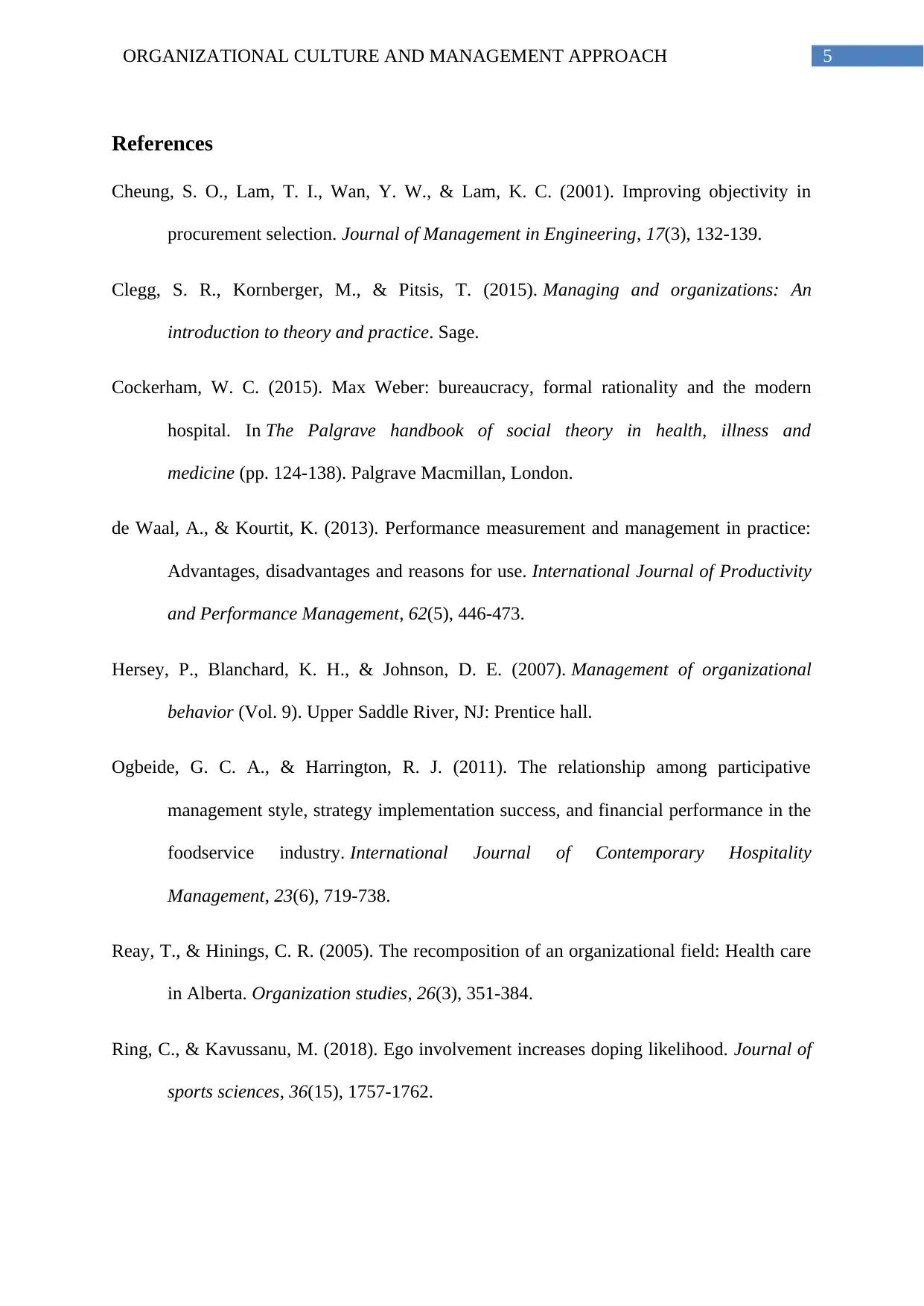
5ORGANIZATIONAL CULTURE AND MANAGEMENT APPROACH
References
Cheung, S. O., Lam, T. I., Wan, Y. W., & Lam, K. C. (2001). Improving objectivity in
procurement selection. Journal of Management in Engineering, 17(3), 132-139.
Clegg, S. R., Kornberger, M., & Pitsis, T. (2015). Managing and organizations: An
introduction to theory and practice. Sage.
Cockerham, W. C. (2015). Max Weber: bureaucracy, formal rationality and the modern
hospital. In The Palgrave handbook of social theory in health, illness and
medicine (pp. 124-138). Palgrave Macmillan, London.
de Waal, A., & Kourtit, K. (2013). Performance measurement and management in practice:
Advantages, disadvantages and reasons for use. International Journal of Productivity
and Performance Management, 62(5), 446-473.
Hersey, P., Blanchard, K. H., & Johnson, D. E. (2007). Management of organizational
behavior (Vol. 9). Upper Saddle River, NJ: Prentice hall.
Ogbeide, G. C. A., & Harrington, R. J. (2011). The relationship among participative
management style, strategy implementation success, and financial performance in the
foodservice industry. International Journal of Contemporary Hospitality
Management, 23(6), 719-738.
Reay, T., & Hinings, C. R. (2005). The recomposition of an organizational field: Health care
in Alberta. Organization studies, 26(3), 351-384.
Ring, C., & Kavussanu, M. (2018). Ego involvement increases doping likelihood. Journal of
sports sciences, 36(15), 1757-1762.
References
Cheung, S. O., Lam, T. I., Wan, Y. W., & Lam, K. C. (2001). Improving objectivity in
procurement selection. Journal of Management in Engineering, 17(3), 132-139.
Clegg, S. R., Kornberger, M., & Pitsis, T. (2015). Managing and organizations: An
introduction to theory and practice. Sage.
Cockerham, W. C. (2015). Max Weber: bureaucracy, formal rationality and the modern
hospital. In The Palgrave handbook of social theory in health, illness and
medicine (pp. 124-138). Palgrave Macmillan, London.
de Waal, A., & Kourtit, K. (2013). Performance measurement and management in practice:
Advantages, disadvantages and reasons for use. International Journal of Productivity
and Performance Management, 62(5), 446-473.
Hersey, P., Blanchard, K. H., & Johnson, D. E. (2007). Management of organizational
behavior (Vol. 9). Upper Saddle River, NJ: Prentice hall.
Ogbeide, G. C. A., & Harrington, R. J. (2011). The relationship among participative
management style, strategy implementation success, and financial performance in the
foodservice industry. International Journal of Contemporary Hospitality
Management, 23(6), 719-738.
Reay, T., & Hinings, C. R. (2005). The recomposition of an organizational field: Health care
in Alberta. Organization studies, 26(3), 351-384.
Ring, C., & Kavussanu, M. (2018). Ego involvement increases doping likelihood. Journal of
sports sciences, 36(15), 1757-1762.
⊘ This is a preview!⊘
Do you want full access?
Subscribe today to unlock all pages.

Trusted by 1+ million students worldwide
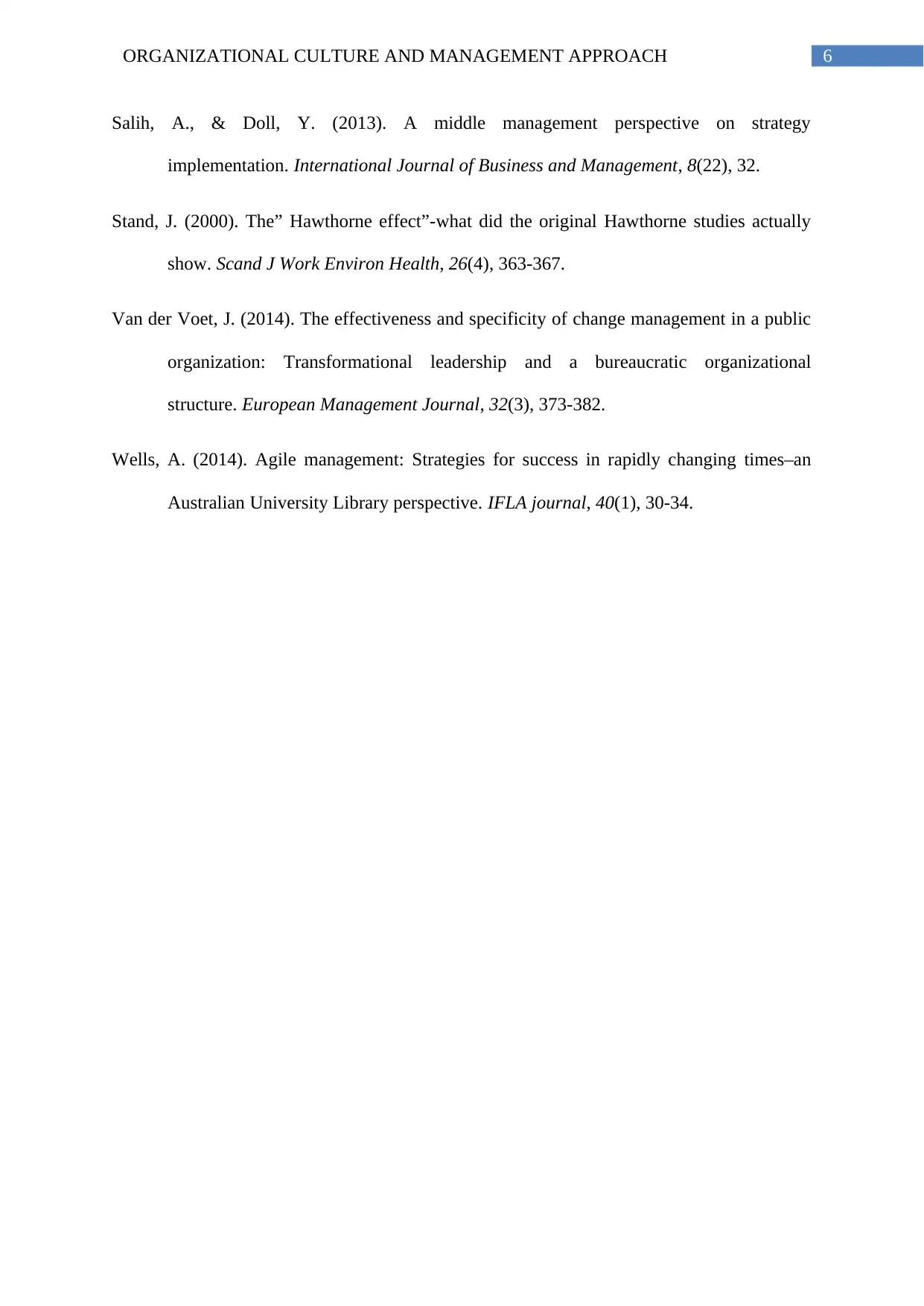
6ORGANIZATIONAL CULTURE AND MANAGEMENT APPROACH
Salih, A., & Doll, Y. (2013). A middle management perspective on strategy
implementation. International Journal of Business and Management, 8(22), 32.
Stand, J. (2000). The” Hawthorne effect”-what did the original Hawthorne studies actually
show. Scand J Work Environ Health, 26(4), 363-367.
Van der Voet, J. (2014). The effectiveness and specificity of change management in a public
organization: Transformational leadership and a bureaucratic organizational
structure. European Management Journal, 32(3), 373-382.
Wells, A. (2014). Agile management: Strategies for success in rapidly changing times–an
Australian University Library perspective. IFLA journal, 40(1), 30-34.
Salih, A., & Doll, Y. (2013). A middle management perspective on strategy
implementation. International Journal of Business and Management, 8(22), 32.
Stand, J. (2000). The” Hawthorne effect”-what did the original Hawthorne studies actually
show. Scand J Work Environ Health, 26(4), 363-367.
Van der Voet, J. (2014). The effectiveness and specificity of change management in a public
organization: Transformational leadership and a bureaucratic organizational
structure. European Management Journal, 32(3), 373-382.
Wells, A. (2014). Agile management: Strategies for success in rapidly changing times–an
Australian University Library perspective. IFLA journal, 40(1), 30-34.
1 out of 7
Related Documents
Your All-in-One AI-Powered Toolkit for Academic Success.
+13062052269
info@desklib.com
Available 24*7 on WhatsApp / Email
![[object Object]](/_next/static/media/star-bottom.7253800d.svg)
Unlock your academic potential
Copyright © 2020–2025 A2Z Services. All Rights Reserved. Developed and managed by ZUCOL.




